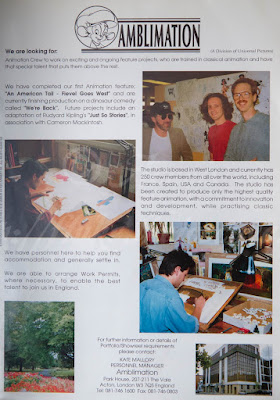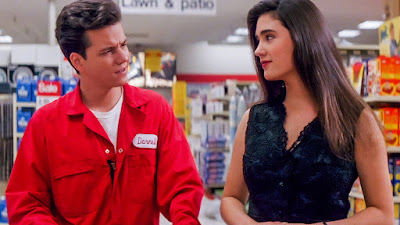WRITER'S NOTE: The following is a collection of reviews posted on my Instagram account @film_freeq in 2022-2023. They’ve been organized by their initial (theatrical) release dates.
***
Career Opportunities (1991)
One of several John Hughes screenplays produced in 1991, Career Opportunities centers on a fast-talking, small town con man (who can't seem to keep a job) picking up a new gig at the local Target store, getting locked in one night with the prettiest girl in town, and standing off against two bumbling crooks. The film not only recycles elements from other (better) Hughes movies (Home Alone and Ferris Bueller, anyone?), but is, ironically, a wasted opportunity for a story about former high schoolers struggling into adulthood. The only bright spots in this crude, sexualized comedy (a young Jennifer Connelly is objectified a lot throughout, while elements of shoplifting and property damage pervade the store) are cameos by John Candy (as a store manager) and William Forsythe (as a snooty custodian). Best to leave this one out of stock.
TRIVIAL FACT: Hughes was reportedly so unhappy with the finished product (accurately marketed as "minimum wage") that he wanted his name removed from the credits, to which the studio refused.

Dutch (1991)
Another Hughes script that recycles elements from his previous films (in this case, Planes, Trains & Automobiles and Uncle Buck) and assembles them into a crude road-trip comedy. Ed O'Neill (at the height of his Married . . . With Children fame) plays the titular working-class wiseguy who, to impress his new girlfriend, agrees to pick up her spoiled-brat, prep-school teenage son and bring him home for Thanksgiving. Dutch starts out decent enough (with dialogue that's actually smarter than the movie looks), but as soon as the unlikely duo first meet, the proceeding adventure results in hijinks that are broad, crass, and sometimes mean-spirited. (Bits about pornographic playing cards, and one distasteful sequence where Dutch and the angst-ridden Doyle are carpooled and robbed by a pair of hookers, are unnecessary and racy.) It's a middling journey with characters that go about their business (and each other) the wrong way.
TRIVIAL FACT: O'Neill and co-star Ethan Embry reunited over a decade later for the TV reboot of Dragnet (2003), as detectives.

Only the Lonely (1991)
The only time John Hughes produced a film he didn't write or direct was with 1991's Only the Lonely. Using the same crew from Home Alone, Chris Columbus penned and helmed this unlikely romantic comedy about a Chicago cop and bachelor who still lives with his mother, until he falls for a funeral parlor cosmetologist. John Candy began showing his more dramatic side as lead Danny Muldoon. (He had a small role in Oliver Stone's JFK the same year, and a more crucial one in 1993's Cool Runnings.)
The genuine camaraderie and dynamics between Candy and co-stars Maureen O'Hara (who returned to the screen for the first time in twenty years, as Candy's stern Irish mother), Ally Sheedy (as the love interest, a far cry from basket case Allison from The Breakfast Club), and Jim Belushi (as a fellow officer) make this an exceptional Hughes entry from the 1990s. The only downsides are a few crass, sex-related, and/or vulgar elements. Only the Lonely turned out to be the last time Hughes and Candy collaborated, until the beloved actor's tragic passing in 1994.
TRIVIAL FACT: Although he and Hughes reportedly didn't get along during the making of Curly Sue that same year, Belushi greatly enjoyed working on Only the Lonely. Macaulay Culkin also makes an appearance, as Candy's nephew.

Curly Sue (1991)
Jim Belushi and Alison Porter play a homeless father-daughter con-artist duo whose latest scheme lands them in the pad of a wealthy attorney. That's the plot of this misguided dramedy, complete with overt sentimentality and mean-spirited slapstick that feels forced and uneven. (Belushi's Bill Dancer sure gets hit in the head a lot.) The only real bright spot is Porter as the titular plucky girl; I'll never forget, as a boy, the moment in TV commercials where she slurps pasta. Curly Sue also marked the feature film debut of actor-comedian Steve Carell, who plays a silent waiter.
Writer-director-producer John Hughes had other screenplays he was planning to make into movies but never did, including a comedy starring Sylvester Stallone and John Candy as feuding neighbors (Bartholomew Vs. Neff), and a romantic comedy starring Hilary Swank as a maid in Chicago (The Chambermaid); the latter was eventually redone by other writers as Maid in Manhattan in 2002, starring Jennifer Lopez and set in New York, as a generic, modern-day Cinderella story. Curly Sue ended up being the last film Hughes would ever direct in his lifetime.
TRIVIAL FACT: Years later, Porter (who previously played one of Steve Martin's children in 1989's Parenthood) would win the 10th season of NBC's The Voice in 2011.

Beethoven (1992)
An amusing family comedy with a St. Bernard as its star (one of the most famous movie animals) and the late Charles Grodin as the stuck-up family patriarch (one of our most memorable movie dads growing up). Watchmojo, perhaps, put it best: "If you grew up in the 90s, you probably know more about the dog than the composer."
Produced by Ivan Reitman, Beethoven is otherwise an overly-sentimental and implausible movie, with a menacing subplot involving a sinister veterinarian that gives Cruella De Vil a run for her money. It is interesting seeing seasoned actors like Stanley Tucci and Oliver Platt (as a pair of dimwitted thieves), as well as David Duchovny and Patricia Heaton (as a sleazy business couple), in earlier film roles. And let's not forget that catchy rendition of Chuck Berry's "Roll Over, Beethoven" (performed by Paul Shaffer and the World's Most Dangerous Band).
TRIVIAL FACT: Co-writer John Hughes was credited as "Edmond Dantes," a pseudonym he used whenever one of his finished scripts differed from his original vision. (The only other times this happened were for 2002's Maid in Manhattan and 2008's Drillbit Taylor.)

Home Alone 3 (1997)
Following two blockbuster installments in the early-90s, John Hughes initially planned a third Home Alone movie with Macaulay Culkin. But when the former child star briefly retired in 1994, Hughes decided to go in a different direction with the franchise, with a new cast but the same formula and hijinks. The result turned out to be the last major theatrical release that bore Hughes' name as writer and producer.
On one hand, Home Alone 3 has a likeable-enough young lead (Alex D. Linz, who later starred in a few Disney films), while a young Scarlett Johannson and Sixteen Candles alum Haviland Morris play the kid's sister and mother, respectively. Plus, series editor Raja Gosnell stepped behind the camera for the first time. And the fact that the storyline (about a group of international thieves looking for a top secret computer chip in a toy car, and an eight-year-old at home with the chicken pox) was a little more plausible, and had a few clever visual elements and amusing moments, is commendable. (The same can't be said for some unnecessary suggestive images.) Overall, it's a forgettable and ridiculous affair. Three cheap sequels that followed in the next two-and-a-half decades further solidified that this franchise was much better at just one movie.

Reach the Rock (1998)
While the 1990s saw John Hughes largely turning out broad and crude family comedies, he did make at least one attempt to reach a young adult audience. Enter this widely-unseen film, written and produced by Hughes, about a town criminal (Alessandro Nivola) who causes property damage and spends the night in a prison cell--in none other than the fictional Shermer, Illinois (home to Hughes' teen movie universe). What follows is a night of theft, rebellion against figures of authority, sneaking or screwing around, lying, and coming to terms with past trauma.
Reach the Rock does have a few intriguing scenes of dialogue and thematic metaphors between Nivola's troublemaking Robin (a close relative of John Bender from The Breakfast Club, perhaps?), William Sadler's police chief, and Brooke Langton's high school crush, regarding missed opportunities, growing up or the lack thereof, and feeling stuck. It very much follows the same structure as 1991's Career Opportunities, but as a dark drama. Hughes' son, John III, served as music supervisor for the film's engrossing soundtrack. But the story seems to wallow in reckless behavior and getting away with it, including a weak subplot about an unprofessional fellow officer trying to impress his girlfriend. SPOILER ALERT: truths do come out, but the outcomes and directions are just as (if not more) problematic. This was the last film personally overseen by Hughes before he left Hollywood for good.

Just Visiting (2001)
While Reach the Rock marked John Hughes' last sole screenwriting credit, technically the last screenplay credited to him was this 2001 medieval comedy, starring Jean Reno as a 12th-Century knight who is transported to present day Chicago and meets one of his descendents (played by Christina Applegate). Although it features Malcolm McDowell as an amusing wizard, this otherwise materialistic remake of the 1993 French film Les Visiteurs (both versions were directed by Jean-Marie Poiré, and this script was co-written by Poiré and co-star Christian Clavier) is loud and broad, with a convoluted story, dated CGI, bizarre imagery, mindless pratfalls, gross-out humor, and sexist gags/elements. This co-production of then-Disney-owned Hollywood Pictures is best left in the past.
Drillbit Taylor (2008)
Three best friends hire a bodyguard to help them navigate high school, more specifically to ward off sadistic bullies. Two things are worth noting about this Judd Apatow-produced comedy from the late-2000s. 1) It was the first leading vehicle for Owen Wilson after a reported suicide attempt the previous year. 2) The movie marks the last produced script originally written by John Hughes (who received story credit under the pseudonym "Edmond Dantes"; screenplay credit goes to Seth Rogen and Kristofer Brown). In fact, Drillbit Taylor feels like it came straight out of the Eighties a la My Bodyguard, Sixteen Candles, and Uncle Buck.
While the repoirte amongst the young leads and Wilson is genuine, the movie's themes of bullying and retaliation are misguided, over the top, and sometimes mean-spirited. Throw in elements of pawning stolen goods (Drillbit is actually a homeless war veteran), crude and raunchy sex jokes, crass language (sometimes offensive), and even passive or dismissive teachers and/or adult figures, and you have a means to seek protection and guidance elsewhere.











































